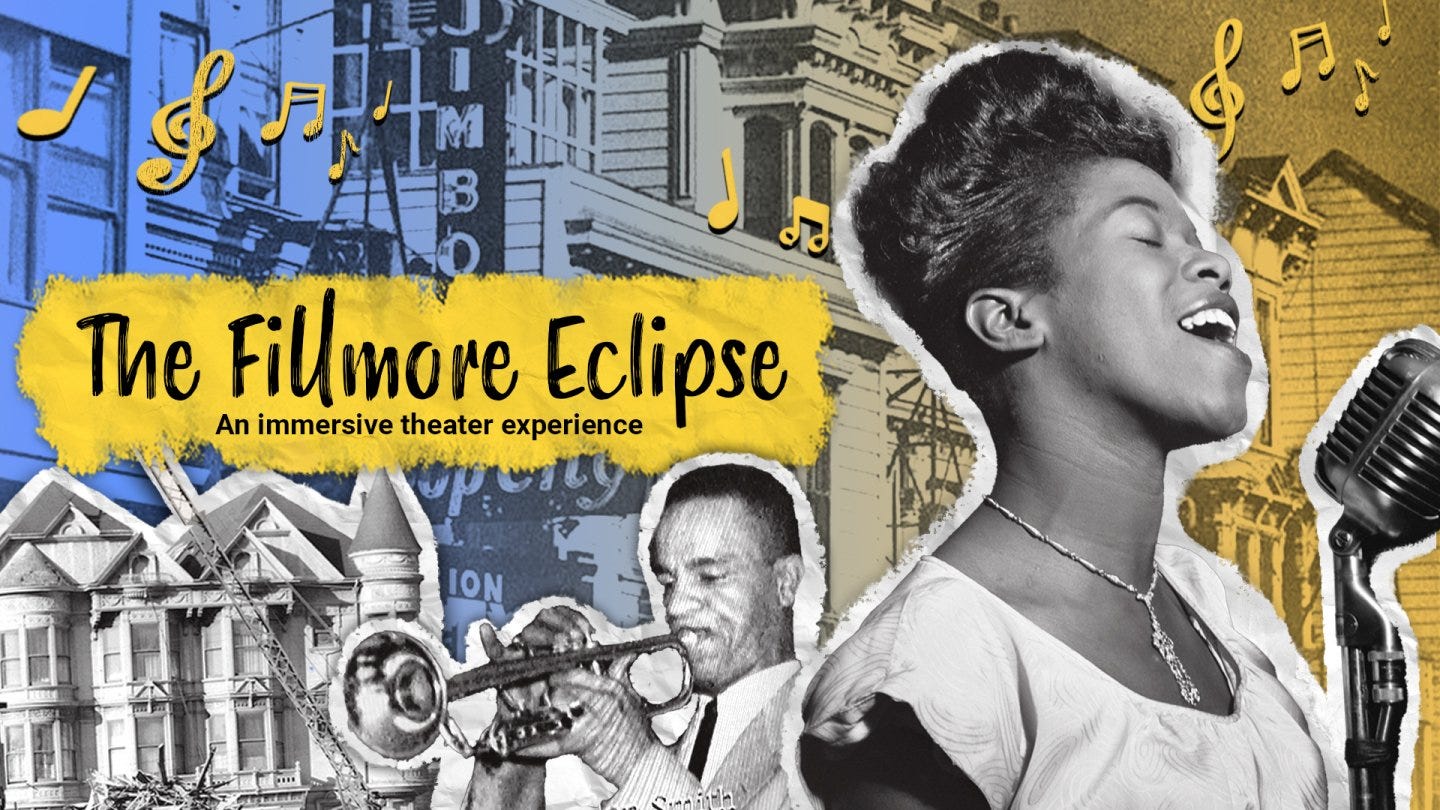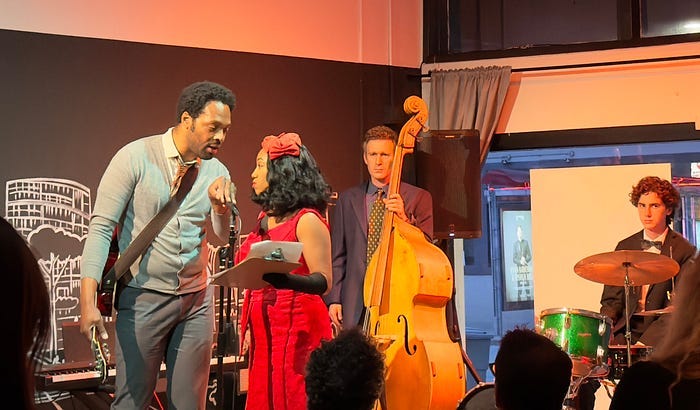NOW PLAYING: The Fillmore Eclipse
San Francisco history comes to life in the first theatrical production from SF’s Walking Cinema


While this is Walking Cinema’s first full theatrical production the company, headed up by producer Michael Epstein, has been making audio and augmented reality driven immersive experiences for years. The company’s signature are stories about places, using technology to bring history to life.
For The Fillmore Eclipse, Walking Cinema turned to writer Cleavon Smith and director Michael French to bring to life a story set in the Bebop Jazz scene of 1950’s San Francisco. A time when the Black community in the Fillmore district was targeted by redevelopment plans that would go on to uproot the nexus of the city’s Black culture.
The initial ten show run of The Fillmore Eclipse sold out, and has since be extended through the end of May. We checked in with producer Michael Epstein about the show. (And you can hear an with him on episode 438 of our podcast.)
This is No Proscenium’s NOW PLAYING, a look at ongoing immersive experiences & events. To learn more about how your event could be considered for the feature check out How To Get Covered By NoPro.
NO PROSCENIUM: Tell us a little bit about your experience! What’s it about? What makes it immersive?
Walking Cinema: The Fillmore Eclipse invites audiences into a late night 1950s jazz club with a story that explores the history of Black art and entrepreneurship in the Fillmore, then known as the Harlem of the West for its expensive music and arts scene. The story also explores the simultaneous disenfranchisement that the community went through during Urban Renewal, when the city of San Francisco forcibly displaced 27,000 residents and demolished existing buildings with promises of a new and better neighborhood for all.
Audiences are invited to interact and follow the stories of regulars of the club on the night before the bulldozers arrive. Although there is a stage for the musicians to perform, the rest of the actors freely intermingle with guests, chatting and sharing their thoughts and concerns on the upcoming Redevelopment plans. Archival documents from the era are dispersed throughout the set, inviting audiences to discover how the city pitched the project and explore the scale of this urban planning debacle. After the show, audiences are invited to a “third act“ in which they can talk with the actors, creators, and each other about the history and ideas of the show.

NP: What was the inspiration for your upcoming experience?
WC: The show was first conceived by Producer and Artistic Director Michael Epstein as he researched a connected immersive audio walk, Museum of the Hidden City. In researching that story, Michael discovered the story of a famed Jazz club whose building was picked up and moved to avoid the wrecking ball. The visual power of buildings being moved around to try and save a culture inspired Michael to create a show in which audiences are both immersed in mid-century African-American culture and can feel it eroding under their feet. The show was also inspired by European filmmakers such as Jonas Carpignano who combine fiction, documentary, and social work in their films.
Get NoPro Newswire’s stories in your inbox
Join Medium for free to get updates from this writer.
SubscribeSubscribe
It’s also worth noting that for the past 15 years, Michael has focused on creating geolocated audio and augmented reality experiences that convert public spaces into stages, telling critical histories in situ. This project was a chance to tell a story in a space that is specifically designed for that story. In a space where community can be formed in an ongoing basis.
NP: What do you think fans of immersive will find most interesting about this latest experience?
WC: The Fillmore Eclipse stands out in its documentary approach to the genre. Playwright Cleavon Smith drew heavily from the historical and contemporary realities of the site itself, as well as many of the cast and crew’s personal relationships with the neighborhood, as essential source material. The father of one of the actors actually played in the band at Bop City (the club much of the set is modeled after) and he grew up going to the club, so this story is deeply personal to him. Another actor has grown up with stories of the Fillmore as her grandmother was born in the neighborhood and directly experienced the internment camps her character struggles with.
The Fillmore Eclipse takes immersive theater into a less explored space of site-specific documentary and working with marginalized communities. The producers worked closely with local African American arts and social service nonprofits to conduct oral histories and bring locals into the cast and production process. This process has created a venue which can support ongoing extensions of the show and local arts experiences. We are also seeing an incredibly diverse audience for shows, both in race, age, political outlook. The conversations audience members have after the show attest to this diversity in the social mission of the production.
NP: Once you started designing and testing what did you discover about this experience that was unexpected?
ME: In our initial workshop in January, we discovered how important it is to initially drop the audience into an active nightclub. This required the development of props, planned improvisations, and a general level of commotion and sound that made the audience feel like they were in a club atmosphere. We also saw how challenging it is to combine live jazz music and dialogue. Often the music was overriding what the actors were saying. So getting the actors properly amplified and the music properly subdued was a big challenge. But in this process, we also discovered that audiences really liked when there was a sort of disconnect between what the actors were saying and doing, and what the music was expressing. Almost like the actors were going through private moments of tragedy while the music conveyed a sense of a larger world that merrily continues on its path despite them.
One of the other big discoveries was how to make immersive theater that has a slower, sad tone to it. Initially the shows were feeling low energy and potentially confusing to audiences whether they should be celebrating the clubs music or mourning the deep losses of a community. Eventually, there emerged a softer, lower tone that didn’t depress audiences as much as put them in a meditational mood. It’s an incredibly challenging balancing act to create a show that has space, silences, and not as many highs as music and period-inspired immersive usually has.

NP: What can fans who are coming to this, or thinking about coming to this, do to get into the mood of the experience?
ME: Listen to any of the many well known Bebop artists who have come through the Harlem of the West and stopped by Bop City to perform in special sessions, such as John Coltrane, Billie Holiday, and Charlie Parker to name a few. You can also read the fantastic photo journalism book “the Harlem of the West“.
And since this is sort of a prequel, audiences can take the free audio and augmented reality walk through the Fillmore, The Museum of the Hidden City. The story actually transpires a decade after the show, but there are three lines in the characters and places mentioned.
Discover the latest immersive events, festivals, workshops, and more at our new site EVERYTHING IMMERSIVE, home of NoPro’s show listings.
NoPro is a labor of love made possible by our generous Patreon backers. Join them today and get access to our Newsletter and Discord!
In addition to the No Proscenium website and our podcast, and you can find NoPro on Facebook, LinkedIn, YouTube, Instagram, and in the Facebook community also named Everything Immersive.